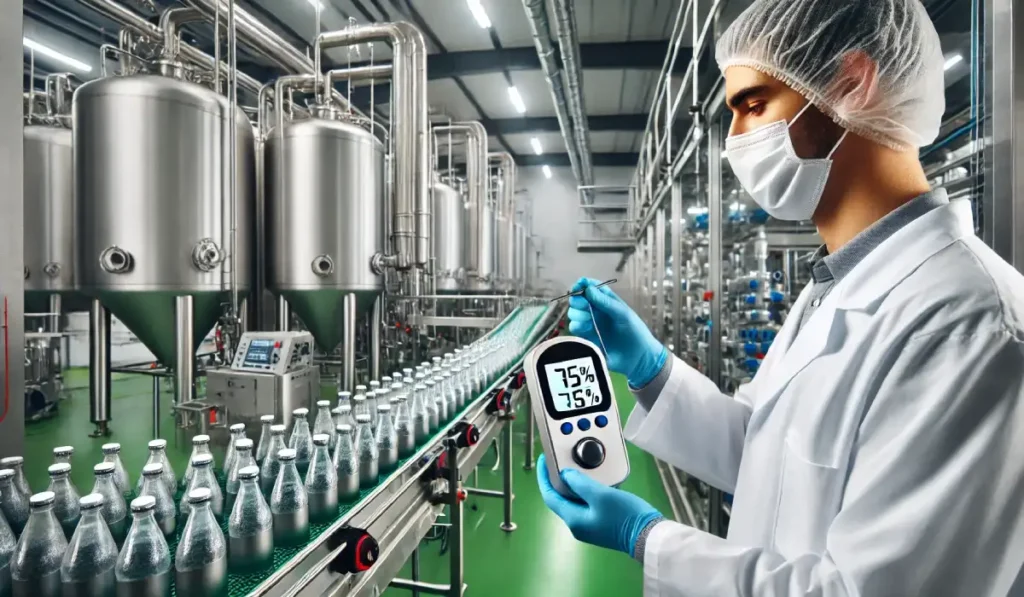Maintaining the right temperature and humidity in food and beverage facilities is crucial to ensuring product safety, quality and compliance with industry standards. Proper environmental control prevents spoilage, enhances shelf life and maintains the integrity of perishable goods. In this guide, we will explore how to maintain ideal temperature in food storage and optimize humidity levels for various food and beverage products.
Importance of Temperature & Humidity Control in Food Storage
Food storage conditions directly impact product safety, taste and texture. Whether storing dairy, meat, fish, or beverages, maintaining ideal temperature food storage conditions helps prevent bacterial growth, contamination and product degradation. Similarly, ideal humidity for food storage ensures moisture-sensitive products do not spoil or become overly dry.
Uncontrolled temperature and humidity can lead to microbial growth, changes in texture and compromised food quality. Therefore, food facilities must implement reliable food facility temperature control systems to ensure regulatory compliance and food safety.

Temperature Control in Food & Beverage Facilities
Best Temperature for Food Processing
In food processing, temperature regulation is critical to maintaining food safety and quality. The best temperature for food processing varies by product type:
- Fresh produce: 1°C to 4°C (33°F to 39°F)
- Dairy products: 0°C to 4°C (32°F to 39°F)
- Meat and poultry: -2°C to 4°C (28°F to 39°F)
- Frozen foods: -18°C (0°F) or lower
For facilities handling meat products, the best temperature for curing meat is typically between 10°C to 15°C (50°F to 59°F) with controlled humidity.
To maintain these standards, food facility temperature control systems, such as food and beverage HVAC solutions, play a crucial role in ensuring stable conditions.
Maintaining Ideal Temperature in Storage
To maintain ideal temperature in food storage, facilities must:
- Use high-efficiency refrigeration and HVAC systems.
- Monitor temperature regularly with automated sensors.
- Implement proper air circulation to avoid temperature fluctuations.
- Ensure regular maintenance of cooling and heating systems.
- Follow strict storage protocols for different food types.
Similarly, how to maintain ideal temperature in beverage storage requires specialized cooling systems to preserve the taste and quality of soft drinks and dairy-based beverages.
Humidity Control in Food & Beverage Processing
Best Humidity Levels for Food Storage
Controlling humidity is as important as temperature regulation. Excess humidity can lead to mold growth, while low humidity can dry out products. Below are the recommended levels:
- Best humidity levels for storing meat: 75% - 85%
- Best humidity levels for storing fish: 85% - 90%
- Best humidity levels for storing dairy: 75% - 85%
Humidity control solutions in beverage manufacturing help prevent spoilage, condensation issues and bacterial growth. Implementing dehumidifiers and proper ventilation can ensure consistent humidity levels across storage areas.
Guide for Humidity Control in Food & Beverage Processing
To achieve optimal humidity control:
- Use dehumidification systems in high-moisture environments.
- Maintain air circulation to reduce condensation risks.
- Install sensors to continuously monitor and adjust humidity levels.
- Use desiccant dehumidifiers for sensitive storage areas.
- Train staff on humidity monitoring and corrective actions.
By following this guide for humidity control in food and beverage processing, facilities can ensure product quality and regulatory compliance.

Common Challenges in Temperature & Humidity Control
Food and beverage facilities often face challenges such as:
- Seasonal temperature fluctuations affecting storage conditions.
- Equipment failures leading to temperature inconsistencies.
- High humidity causing condensation and microbial growth.
- Power outages disrupting climate control systems.
Implementing backup power solutions, routine maintenance and advanced climate control systems can help mitigate these challenges.
Conclusion
Effective temperature control in food processing and humidity management are essential for food and beverage facilities. Investing in food and beverage HVAC solutions ensures products remain safe, fresh and high-quality. By maintaining ideal temperature food storage and regulating humidity, businesses can reduce waste, improve efficiency and meet industry standards.
For expert solutions in temperature and humidity control, consider upgrading your facility with advanced HVAC and refrigeration systems tailored to your specific needs.
Keep your food and beverages fresh with reliable HVAC solution—Contact us now!
FAQs
Temperature control prevents bacterial growth, spoilage and quality degradation in food products, ensuring food safety and compliance with health regulations.
The ideal temperature for dairy storage is between 0°C and 4°C (32°F to 39°F) to maintain freshness and prevent spoilage.
Using dehumidifiers, proper ventilation and real-time humidity sensors can help maintain the recommended humidity levels in food storage facilities.
High humidity can lead to mold growth, condensation and bacterial contamination, affecting the safety and shelf life of stored food products.
Meat should be stored at -2°C to 4°C (28°F to 39°F) for short-term storage and at -18°C (0°F) or lower for long-term freezing.
Humidity control prevents condensation, mold growth and spoilage in beverage manufacturing facilities, ensuring product stability and quality.
